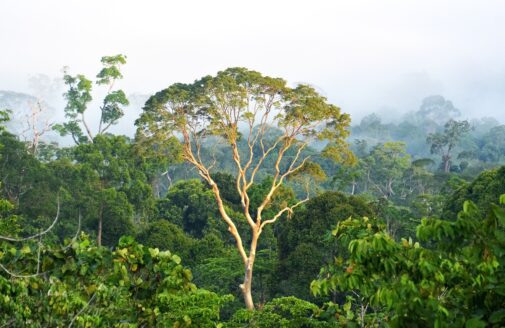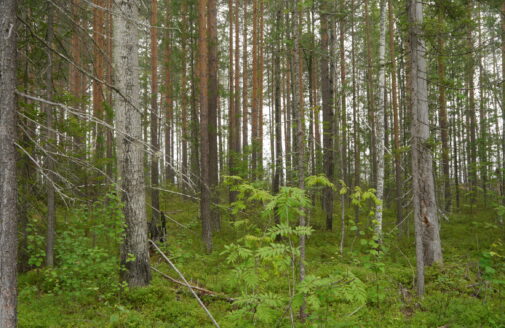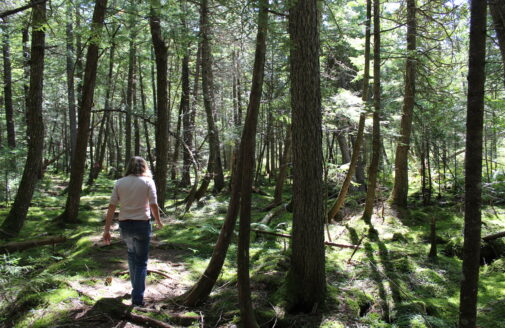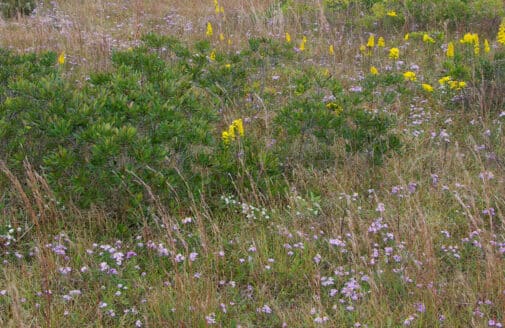What you should know about protecting the United States’ old forests
The U.S. is at a decision point for the protection of mature and old-growth forests and the carbon they store
Carbon monitoring equipment over Howland Forest in Maine.
photo by Miles Grant
On April 20, 2023, the U.S. Department of the Interior (DOI) and Department of Agriculture (USDA) released a first-of-its-kind inventory of the country’s mature and old-growth forests. The assessment responded directly to a 2022 executive order aimed at fostering healthy forests.
The inventory highlights the importance of forest health in building resilience to future climate-related disturbances like drought or fire, but it omits mention of the service that all forests, but particularly mature and old growth forests, provide in directly mitigating the country’s carbon emissions—a service that Woodwell Climate’s scientists have worked to measure and monitor for over three decades.
The inventory is a critical starting point, from which agencies like the U.S. Forest Service and the Bureau of Land Management will begin to make decisions about how public forests are managed going forward. Not acknowledging the critical carbon storage contribution of mature and old-growth forests runs the risk of de-prioritizing protection for the country’s oldest, most carbon-rich, and hardest to replace ecosystems.
Howland Forest, Maine.
photo by Kathleen Savage
Why protect mature and old-growth forests?
In short: carbon. While all forests sequester carbon as they grow, older and larger trees represent an existing store of carbon in their biomass and soil. Research by Woodwell Climate scientists on carbon stocks in a sample of federally managed U.S. forests found that while larger trees in mature stands constitute a small fraction of all trees, they store between 41 and 84 percent of the total carbon stock of all trees.
An analysis of mature and old growth forests across the country found that approximately 76 percent (20.8 million hectares) of these forests are unprotected from logging. This represents an amount of carbon roughly equivalent to one quarter of the U.S.’s annual fossil fuel emissions.
Although younger forests grow faster proportionally, they are not adding as much carbon in a single year as older forests with large trees. Additionally, mature forests continue to pack away carbon year over year in their soils, which is largely protected from effects of disturbance. Cutting down a mature forest creates a “carbon debt” that can take decades—centuries in some cases—to recoup, and in the meantime those mature trees are no longer sequestering carbon each year.
“Forests are like naturally occurring factories, delivering to the planet the unique service of carbon sequestration. Trees of all sizes, but particularly large old trees, are the equivalent of warehouses where the goods produced—tons of carbon—are stored over time,” says Woodwell Climate Carbon Program Director, Dr. Wayne Walker. “Like any warehouse where valuable goods are stored, these natural carbon reserves deserve all the protection we can provide. Their loss could effectively bankrupt our efforts to avoid the worst impacts of climate change.”
Defining mature and old-growth forest
Protecting mature forests requires them to be identified and mapped, which was part of the impetus behind the government’s forest inventory. But what actually is a mature forest?
Definitions of “mature” and “old-growth” differ, with no one universally accepted definition. Refining scientific understanding of what constitutes a mature forest has implications for either expanding or reducing the area of forest considered for protection.
In one study of U.S. forest carbon stocks, Woodwell Climate researchers and collaborators outlined a measure of forest maturity based on both the age that the tree canopy in a forest becomes 100 percent closed, called “Culmination of Net Primary Productivity,” and tree diameter size. Across 11 U.S. forests analyzed, the age at which a forest is considered mature ranged from 35 years in Appalachian forests to 75 in Arizona. “Old-growth” represents a smaller subset of mature forests having older and larger trees.
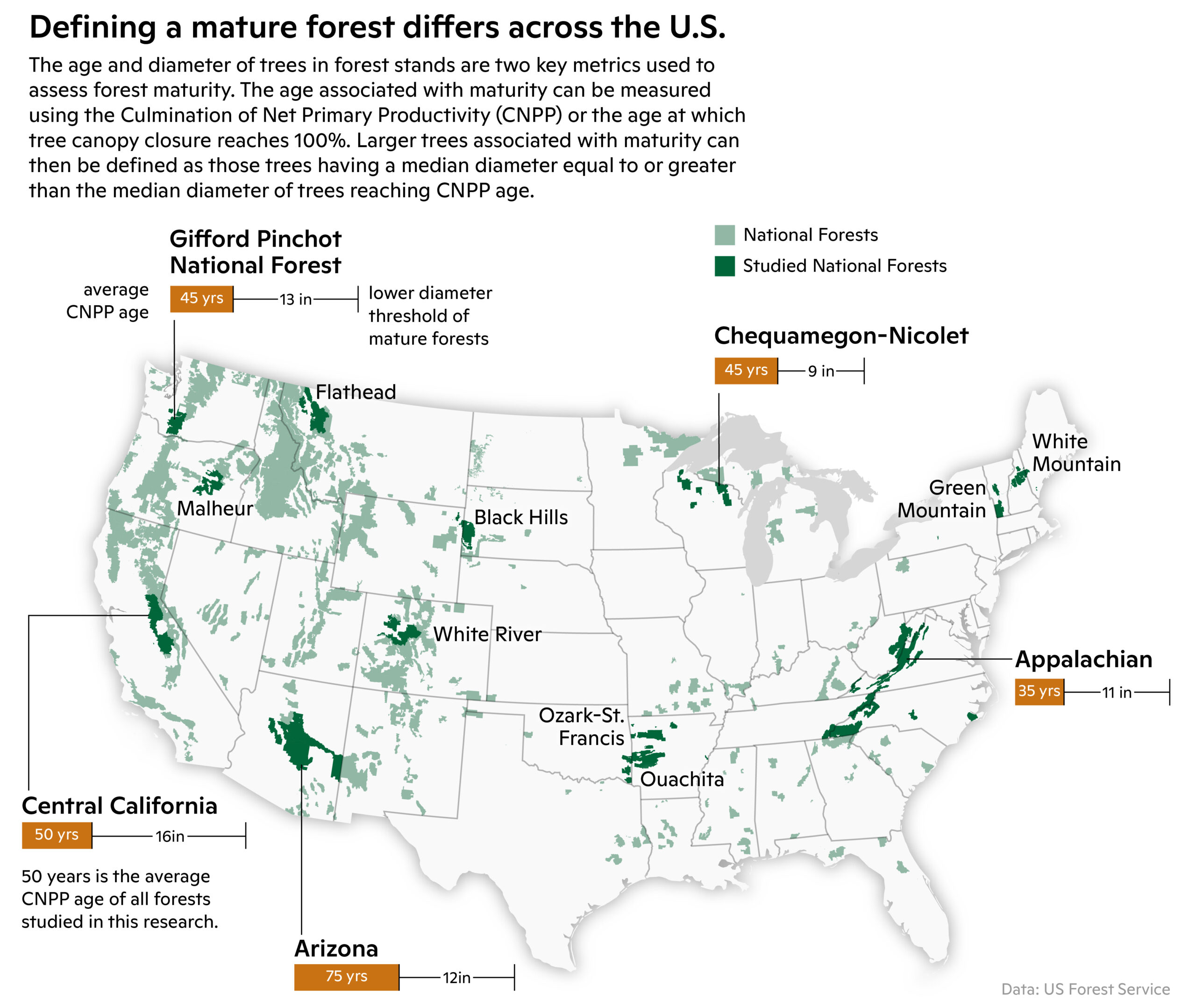
map by Christina Shintani
The new inventory from the DOI and USDA uses a slightly narrower definition of maturity, wherein the lower bound occurs when regeneration has begun underneath the canopy. This results in a slightly smaller estimation of the amount of mature and old-growth forests in the U.S.—yet still approximately 63 percent of the total area of federally managed forests.
Other definitions can be based on models that take into account measurements of forest structure like canopy height, canopy cover, and biomass. Another study, co-authored by Woodwell Climate Associate Scientist, Dr. Brendan Rogers, used these features to determine that federal lands contain the largest concentration of the country’s mature and old growth forests.
Differences in those definitions are important, because forest policy debates surrounding the responsible management of these forests depend on adequately identifying them, particularly mature forests, which are much more loosely defined than old-growth.
“I think the discussion is almost more about what to do with mature forests, as opposed to old-growth,” says Woodwell Climate Senior Scientist, Dr. Richard Birdsey, who worked in the U.S. Forest Service for four decades. “Mature forests are at a younger stage of growth—trees would be smaller, although they could still be substantial in size and very profitable to harvest. So the question here is whether to let those forests grow into old-growth characteristics, or to start harvesting them for wood products.”
Burned black spruce forests.
photo by Brendan Rogers
What do we do with our mature forests?
When climate benefits are explicitly considered, the research points strongly to letting these forests grow—protecting and expanding the massive portion of sequestered carbon they represent.
According to Birdsey, the largest threat facing mature and old-growth forests in the U.S. is logging, which is a threat that humans can reduce instantly, simply by changing policy. A change that would make those forests more resilient to other threats in the long run.
“Others might argue that climate change or wildfire are more significant threats,” says Birdsey. “Older forests with larger trees are more resistant to those threats—but not more resistant to chainsaws. That’s a human decision.”
A recent paper in Nature Climate Change has laid out a “protect, manage, restore” framework for making decisions about what natural climate solutions to pursue, and the highest priority is always to protect carbon where it is already stored. U.S. policies have made some recent progress in this direction through the enforcement of the roadless rule on Alaska’s Tongass National Forest, prohibiting road-building and industrial logging on the nine million acre temperate rainforest. But there is still further to go to capitalize on the carbon storage potential of the U.S.’s mature forests.
Federally managed forests contain more high-carbon trees than other lands, so the opportunity for increased carbon storage within them is greatest. Woodwell Climate Distinguished Visiting Scientist, Dr. William Moomaw, helped coin the term “proforestation” to refer to the strategy of letting forests continue to grow as a carbon solution. In order to achieve that, he says, mature forests have to be protected.
“The next steps should be to provide legal protection of as much of these high-carbon forests as possible,” says Moomaw. “These are public lands that should serve the public good, and reducing climate change is a public good that we should pursue as the highest priority.”




